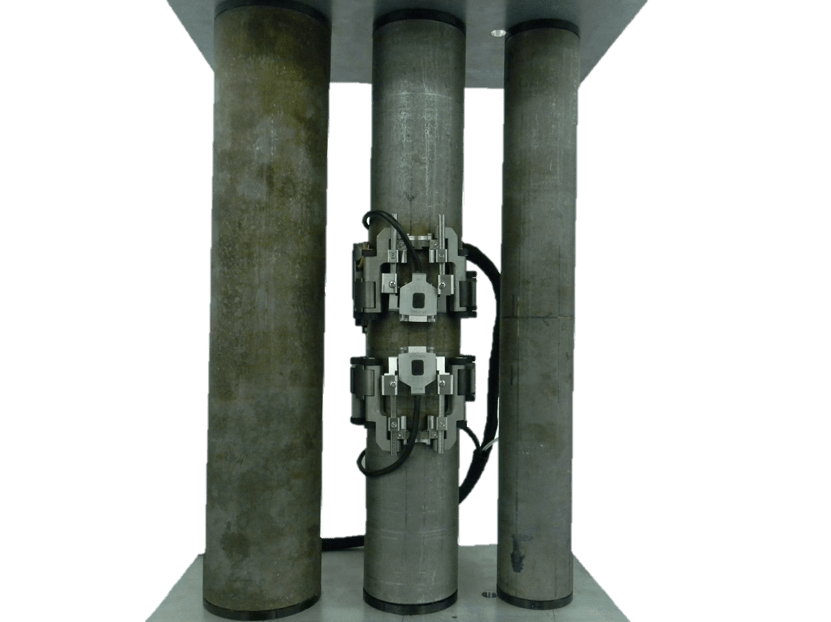How Nondestructive Testing of Boiler Tubes Solves Major Challenges

Boiler tubes are a key component of steam power and as such are subjected to terrible force. This means that boiler tube weld inspection is crucial to keeping mission-critical operations safe.
Over time, phased array ultrasonic testing (PAUT) has emerged as one of the best means of non-destructive testing (NDT) of boiler tubes. This technique allows for comprehensive inspections that reduce downtime and promote thorough preventative maintenance. The high-speed testing process is uniquely designed to fit the challenging environments and tight spaces most boiler tubes are in.
The Challenges of Boiler Tube Weld Inspection
The conditions in which tubes are welded to begin with can pose unique challenges: the intense heat, the welder is often at a strange angle and possibly far off the ground, and it requires equal measures of nuance and power. There’s a reason welders are in a league of their own.
As a result, the attempt to measure defects often includes obstacles such as:
- Various pipe diameters during the same job
- Low ceiling-clearance
- Interlocking pipes inhibiting movement
- Weld caps and other planar defects
Not only that, but the boiler tubes can be generating power for everything from a factory to a nuclear power plant. With these challenges in mind, it’s essential that boiler tube weld inspection minimizes disruption of service and preserves uptime.
That’s why the inspection technique has to be specially designed for the job. Traditional methods, such as radiography have been useful but they come with a lot of problems, including the disruption of service and health hazards.
There are better ways to ensure safety and continuity of service.
Nondestructive Testing of Boiler Tubes
Perhaps the best method of boiler tube inspection is Phased Array Ultrasonic Testing (PAUT), paired with Time of Flight Diffraction (TOFD). With a single system, engineers and inspectors have the coverage they require to ensure consistent operations.
PAUT pulses through pipes with computer-timed calculations. It can pulse multiple beams from different angles both simultaneously and sequentially, which creates a complete cross-section even at strange angles. Because of this ability to probe uneven surfaces, such as weld caps, it is especially valuable for boiler tube inspection.
Time of Flight Diffraction is used specifically for welding inspection, using longitudinal waves that detect sensors on either side of the weld (especially axial and circumferential weld seams). If the beam comes into contact with a flaw in the weld, it diffracts its energy. This gives an accurate picture of the size and shape of any cracks in the weld.
PAUT and TOFD combine to overcome most of the challenges of radiography. They can detect most defect types, particularly planar defects. This includes lack of root fusion, lack of root penetration, weld root crack, and weld tow crack. This means it’s hard to miss any flaws that are passed over.
Compared to radiography, PAUT and TOFD benefits include:
- Better flaw detection and sizing
- Immediate feedback
- Little or no disruption to other activities
In other words, the combination of PAUT and TOFD is better at painting a complete picture, especially when using the right equipment.
The Best Equipment for Nondestructive Testing of Boiler Tubes
The most important piece of equipment for boiler tube testing is a fully-integrated PAUT unit. It has all the tools needed to set up and deploy inspection techniques. It’s adaptable for the job and sized for convenience in the tough environment of boiler tubes.
It serves as a one-stop-shop: a comprehensive tool for everything from preparation to reporting. With an ability to combine phased array and TOFD techniques, analysts get a complete picture of the pipe. Add to that low-clearance scanners that allow on-line circular movement combined with low-clearance probes and wedges for easy use on a pipe. This lets technicians obtain high-speed readings, with acquisition from two sides in under a minute.
PAUT and TOFD are both designed for rapid nondestructive testing, which reduces outage time. Unlike radiography, production shutdowns aren’t required during inspection. A quality PAUT unit will also feature software capabilities that provide an efficient workflow. It’s easy to use, from set-up to reporting, with comprehensive analysis tools. This allows for smarter and faster workflows without disruption from trying to dig through multiple interfaces from multiple instruments and tools.
Steam has been powering the world for hundreds of years. With advanced boiler tube testing, power can be maintained in a safe, efficient way.
Zetec is a major provider of phased array solutions for nondestructive boiler tube testing. Contact us today to get the best equipment and the top solutions to keep your pipes powered up.

Zetec’s designers are industry-leading experts in ultrasonic and eddy current technologies, and we can help you navigate any of our NDT testing solutions or devices.
